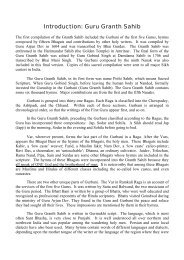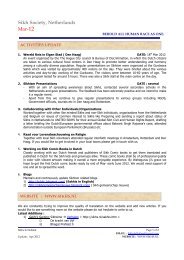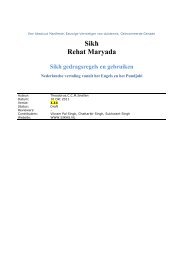Create successful ePaper yourself
Turn your PDF publications into a flip-book with our unique Google optimized e-Paper software.
WWW.UNITEDSIKHS.ORG<br />
Email:<br />
contact@unitedsikhs.org
UNITED SIKHS<br />
• UK - UNITED SIKHS is registered as a Charity in<br />
England and Wales. Charity Number 111 2055.<br />
• USA - UNITED SIKHS is registered as a nonprofit<br />
tax exempt organization pursuant to<br />
Section 501(c)(3).<br />
• India - UNITED SIKHS is registered under the<br />
Societies Registration Act 1860 in Panjab.<br />
• France - UNITED SIKHS is registered under the<br />
<strong>French</strong> Association Law 1901.
<strong>French</strong> <strong>Sikh</strong> <strong>History</strong><br />
80,000 <strong>Sikh</strong>s Fought For France’s Freedom<br />
Wearing Their Turbans<br />
On the Front Line<br />
During the World Wars<br />
There are <strong>Sikh</strong>s in 151 Cemeteries in France who<br />
died Fighting For France’s Freedom, Liberty and<br />
Honour.
A drawing by Paul Sarrut, a <strong>French</strong> artist, 1915<br />
<strong>Sikh</strong>s & Their Turbans<br />
“We shall cherish above all the<br />
memory of their example. They<br />
showed us the way, they made<br />
the first steps towards the final<br />
victory.”<br />
— Marshal Foch : <strong>French</strong> Army<br />
Signed the Armistice Day<br />
Document WWI 1918
“The scene is one that should be retained on the Empires retina. The hosts of Indian soldiers marched through<br />
the streets of Marseilles with the population, especially the female proportion, hanging onto the arms of<br />
bewildered <strong>Sikh</strong>s and Pathans.”<br />
The Martial races of India, Lt Gen Sir George MacMunn, 1923
“The English and the women of this place [France] are very pleased to see us, like opening flowers. They<br />
shake hands with our men when they disembark, and attempt to feed them from their own pocket...”<br />
From a letter, dated 15th December 1915, written by a <strong>Sikh</strong> cavalry soldier at a Marseilles Depot.<br />
Further Extracts from Reports made by the Censor, Indian Mails in France, British Library.
RESPECT
FRIENDSHIP
CONTRIBUTION
SACRIFICE
HONOUR
Major battles in France during World War I in which <strong>Sikh</strong> troops fought:<br />
Ypres • La Bassée • Neuve Chapelle • Festubert • Loos • Givenchy • Somme
SACRIFICE<br />
<strong>Sikh</strong> Soldiers at the Battle on the Somme, France 1916<br />
On October 7 <strong>Sikh</strong> despatch riders with their bicycles at the cross roads of Fricourt and<br />
Mametz Road during the Battle of the Somme in July 1916. The bicycles of the two men in<br />
the foreground are fitted with a special bracket to support their rifles. The man in front has<br />
the rank of Sergeant shown by the stripes on his right shoulder. The loss of life on the<br />
Somme was terrible.
<strong>Sikh</strong> Soldiers World War 1 , Vraignes, France.<br />
On October 7 <strong>Sikh</strong> despatch riders with their bicycles at the cross roads of Fricourt and<br />
Mametz Road Three members of an Indian regiment carrying their lances, the 9th<br />
Hodson's Horse, consult a map near Vraignes, France in 1917. World War One was the<br />
last time that cavalry forces were used in battle, the idea being that infantry forces would<br />
break through the enemy’s frontline defences followed by the cavalry using their superior<br />
speed to reach the enemy’s rear positions and destroy supply and communications lines.<br />
In reality, by the end of the war, many cavalry troops were being used as infantrymen.
Neuve Chapelle - India's Memorial in France<br />
On October 7, 1927 the noble Memorial at Neuve Chapelle was<br />
unveiled in France in memory of all Indian soldiers who fell on the<br />
Western Front in the Great War of 1914-1918.<br />
It marked the gratitude of the great <strong>French</strong> nation which was defended<br />
from German invasion by the supreme sacrifices of the British Indian<br />
Army in France. It marks the <strong>French</strong> gratitude of the <strong>French</strong> people<br />
who built it on their soil.<br />
For the ceremony, special units including <strong>Sikh</strong>s who engaged in the<br />
actual war were brought from India.<br />
A tablet bears the following inscription:<br />
TO THE HONOUR OF THE ARMY OF INDIA WHICH FOUGHT IN<br />
FRANCE AND BELGIUM 1914-1918, AND IN PERPETUAL<br />
REMEMBRANCE OF THOSE OF THEIR DEAD WHOSE NAMES ARE<br />
HERE RECORDED AND WHO HAVE NO KNOWN GRAVE.<br />
Neuve Chappelle – India’s Memorial in France 1914-1918, London, Hodder<br />
& Stoughton, 1927.
Neuve Chapelle – A <strong>Sikh</strong> soldier’s legacy<br />
In March 1915 the Allies attacked Neuve Chapelle and broke<br />
through the German front line. On the first day of the battle, British<br />
and Indian troops captured the town. Then the Germans counterattacked<br />
with 16,000 reinforcements.<br />
In three days’ fighting, the British and Indian troops suffered 13,000<br />
casualties. The Allies’ ammunition ran out, and the troops had to<br />
retreat. 5,021 Indian soldiers - about 20 per cent of the Indian<br />
contingent - were killed in heavy fighting, and Manta Singh was<br />
injured in action after helping to save the life of an injured officer,<br />
Captain Henderson. (In the Second World War, the sons of both of<br />
these men served side by side and became lifelong friends.)<br />
In 1993 Manta Singh’s son, Lt Col Assa Singh Johal, was part of a<br />
delegation of the Undivided Indian Ex-Servicemen’s Association<br />
that visited the Indian war memorial at Neuve Chapelle. Assa Singh<br />
said, “It was a moving visit of great sentimental value to us. We<br />
were able to remember and pay homage to the fallen in foreign<br />
lands.”
Neuve Chapelle – Marshall Foch’s testimony<br />
Speaking in <strong>French</strong>, Marshal Foch told of India's effort in<br />
the Allied cause, how she had raised more than a million<br />
soldiers, how she had lost upwards of one hundred<br />
thousand men. After telling the story of the battles from the<br />
10th to 13th March, 1915, the Marshal described how the<br />
Indian Corps opened the attack.<br />
“The Indian Troops,” he said, “were thus among the first to<br />
show the way to a victorious offensive. It is only right that a<br />
Memorial should perpetuate the glorious memory of<br />
officers, non-commissioned officers, and men of the Indian<br />
Army at the very spot where later on a general attack by the<br />
Allied troops was to bring the decisive victory in sight.”<br />
Turning to the Indian Contingent, he bade them:<br />
"Return to your homes in the distant, sun-bathed East and<br />
proclaim how your countrymen drenched with their blood<br />
the cold northern land of France and Flanders, how they<br />
delivered it by their ardent spirit from the firm grip of a<br />
determined enemy; tell all India that we shall watch over<br />
their graves with the devotion due to all our dead. We shall<br />
cherish above all the memory of their example. They<br />
showed us the way, they made the first steps towards the<br />
final victory."<br />
Neuve Chappelle – India’s Memorial in France 1914-1918,<br />
London, Hodder & Stoughton, 1927
“In the last two world wars 83,005 turban wearing<br />
<strong>Sikh</strong> soldiers were killed and 109,045 were wounded<br />
for the freedom of Britain and the world during shell<br />
fire, with no other protection but the turban, the<br />
symbol of their faith.”<br />
— General Sir Frank Messervy KCSI, KBE, CB,DSO
Hardit Singh Malik, shaking President Coty's hand after receiving the<br />
<strong>French</strong> Legion of Honour Award in 1952.
Hardit Singh Malik<br />
received the <strong>French</strong><br />
Legion of Honour<br />
Award as a fighter pilot<br />
ace for the <strong>French</strong> Air<br />
Force, with 9 victories in<br />
WWI
Hardit Singh Malik visiting Paris in 1949 as an Indian Ambassador to France.
Ambassador Hardit Singh Malik, presented officers of the Embassy, to the president.<br />
From L to R Shri R. Goburdhun, Counsellor, Brigadier K.C. Khanna, Military Attache,<br />
Mr. S.G. Ramachandran, First Secretary (Commercial), Mr. R. Venkateswaran, First<br />
Secretary and Mr. P.G. Pendsay, Press Attache.
Hardit Singh Malik, joined as an ambulance driver with the<br />
<strong>French</strong> Red Cross in early 1916.
Hardit Singh Malik,<br />
saving <strong>French</strong> lives with<br />
the Nursing staff.<br />
Hardit Singh Malik, an Officer in<br />
the <strong>French</strong> Red Cross.
<strong>Sikh</strong>s in over 100<br />
<strong>French</strong> Cemeteries<br />
“In the last two world wars 83,005 turban<br />
wearing <strong>Sikh</strong> soldiers were killed and<br />
109,045 were wounded for the freedom<br />
of Britain and the world during shell fire,<br />
with no other protection but the turban,<br />
the symbol of their faith.”<br />
— General Sir Frank Messervy KCSI,<br />
KBE, CB,DSO
Wounded Indian soldiers, according to one source in a <strong>French</strong> village and another in<br />
Ieper, 31 October 1914. Imperial War Museum, London.
The arrival of <strong>Sikh</strong> soldiers in Marseilles, 1914. Gentlemen of India marching to chasten<br />
German hooligans says a <strong>French</strong> postcard.
FERME DU BOIS,<br />
France 1914.<br />
'How Lieutenant Smyth, of the<br />
15th <strong>Sikh</strong>s, Won the V.C.<br />
and Ten Brave Indians the<br />
Indian Distinguished Service<br />
Medal, at the Ferme du Bois<br />
They were: Sepoys Fatteh<br />
Singh, Ganda Singh, Harnam<br />
Singh, Lai Singh, Naik Mangal<br />
Singh; Sarain Singh,<br />
Sapooram Singh, Sucha<br />
Singh, Sunder Singh, and<br />
Ujagar Singh.<br />
There are no finer fighting men in our Indian Army than the <strong>Sikh</strong>s, the descendants of those<br />
fierce long haired warriors who fought so stubbornly against us at Firozshah and Chilianwala, and<br />
afterwards stood so loyally by the British Raj in the dark days of the Mutiny. And there are no finer<br />
officers in the world than the men who lead them, for no youngster stands a chance of being<br />
gazetted to a <strong>Sikh</strong> regiment who has not shown that he possesses in a marked degree all the<br />
qualities which are likely to ensure the confidence and devotion of those whom he aspires to<br />
command. Source from 'Deeds That Thrill the Empire'
The Indians didn't give them much time to arrive at an understanding. With a shrill yell they rode<br />
right through the German infantry, thrusting right and left with their terrible lances, arid bringing a<br />
man down every time. The Germans broke and ran for their lives, pursued by the Lancers for about<br />
a mile. Our swarthy soldiers from the East have been delighted to win the cheers of the British and<br />
<strong>French</strong> troops. Source from 'T.P.'s Journal of Great Deeds Of The Great War', November 21, 1914
Indian troops train in France during World War I (1914-1918).
General Jean Francois Allard (1785 - 1839) received the highest military medal of the<br />
<strong>Sikh</strong> Kingdom of Maharaja Ranjit Singh, ‘The Bright Star of Punjab’ as well as the<br />
<strong>French</strong> Legion of Honour from Napoleon Bonaparte.
• General Jean Francois Allard (1785-1839) and His Family in the <strong>Sikh</strong> Kingdom<br />
of Lahore<br />
• Painted in Lahore, 1838<br />
• General Allard was born in St. Tropez in 1785 and enlisted at 18 in Napoleon’s 23rd<br />
Dragoons of the Line. He joined Napoleon during the One Hundred Days, and was a<br />
captain of the Cuirassiers at Waterloo. After the emperor’s downfall, he was<br />
considered so ardent a Bonapartist that he received no pension. Still eager for a<br />
military career, he went to Teheran and finally to Kandahar before eventually arriving<br />
in the <strong>Sikh</strong> kingdom of Lahore on March 23, 1822.<br />
• He was hired by Maharajah Ranjit Singh to train two regiments, one of dragoons, the<br />
other of lancers in the <strong>Sikh</strong> army. When his men proved themselves in battle against<br />
the Afghans, Maharajah Ranjit Singh enlarged Allard’s troops to four regiments,<br />
totaling 3,000 men. In addition he was soon assigned 2,000 of artillery. Never<br />
forgetful of France, General Allard’s troops, the “Francese Campo,” flew Lafayette’s<br />
flag in the Khalsa army of Ranjit Singh.<br />
• The painting shows General Allard with his native wife and children and servants at<br />
tea time in front of their great house at Anarkali, a suburb of Lahore. General Allard<br />
has a great and illustrious military career commanding his <strong>Sikh</strong> troops and was well<br />
regarded by them as well as the Maharaja. He briefly returned to France between<br />
1834 to 1836 before returning to Lahore and resuming his military command where<br />
he eventually died of natural causes in January, 1839.<br />
• The portrait not only celebrates the General’s beloved native Punjabi family but also<br />
his dual allegiance to France and Punjab and it’s two greatest leaders, for hanging<br />
round his neck in the painting is Maharaja Ranjit Singh’s Bright Star of Punjab, the<br />
highest military medal of the <strong>Sikh</strong> kingdom and above that the Legion of Honour<br />
bestowed by Napoleon Bonaparte.
Acknowledgements<br />
The British Library<br />
•<br />
Imperial War Museum<br />
•<br />
MG Trust<br />
•<br />
T P’s Journal of Great Deeds Of The Great War<br />
•<br />
Parmjit Singh<br />
•<br />
Sandeep Singh Brar (sikhs.org)<br />
•<br />
Hardit Singh’s Family








